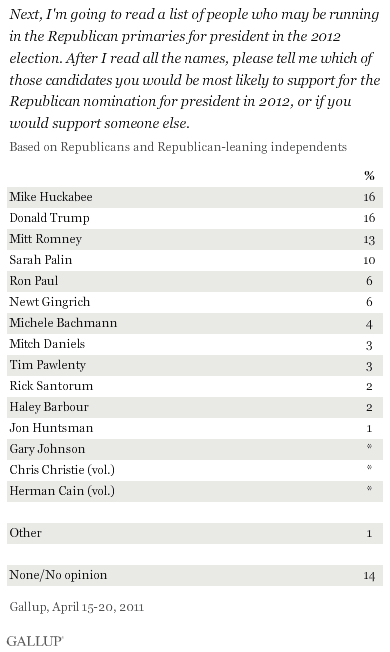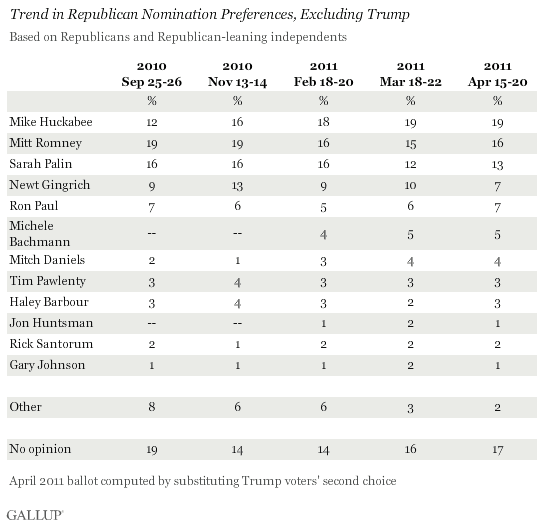PRINCETON, NJ -- Donald Trump debuts in a first-place tie in Gallup's latest update of Republicans' preferences for the party's 2012 presidential nomination among potential contenders. Trump ties Mike Huckabee at 16%, with Mitt Romney close behind at 13%. Sarah Palin is the only other potential Republican candidate to earn double-digit support.

The April 15-20 Gallup poll finds Trump leading the field among moderate and liberal Republicans, with 21% supporting him. Huckabee is the leader among conservative Republicans. Huckabee's support and Trump's support differ between ideological groups, while Romney and Palin get similar support from both ideological wings of the party.
Among the lower-ranked candidates, Newt Gingrich's support and Michele Bachmann's support tilt decidedly conservative. Trump is the only potential candidate who shows notably stronger appeal to liberals and moderates than to conservatives within the GOP.

To stay competitive, Trump would need to maintain a decent level of support among conservatives, since they outnumber moderates and liberals by about 2 to 1 among rank-and-file Republicans and Republican leaners. For the same reason, Huckabee's smaller support among moderates and liberals is less of an issue if he maintains his top standing among conservatives.
Trump's Support Would Generally Go to Other Leaders if He Does Not Run
Gallup included Trump as an explicit choice in its monitoring of GOP preferences for the first time in April 15-20 polling. In recent months, Gallup surveys in which Trump was not offered as an explicit choice found 1% or less of Republicans volunteering his name as the potential candidate they are most likely to support for the GOP presidential nomination.
The likelihood of Trump's officially entering the race is still unclear, with many continuing to wonder whether his public discussion about running for president is serious or designed to attract publicity to himself and his reality television show.
The poll asked for Republicans' second choice for the nomination, allowing for an analysis of what preferences would look like without Trump in the field. Under that scenario, most of Trump's support is spread among the other leading candidates, with Huckabee's support climbing to 19%, followed by Romney at 16% and Palin at 13%.
Those numbers are similar to what Gallup has found in recent months, before Trump's inclusion. The most notable change since March is the dip in support for Newt Gingrich, from 10% to 7%, a new low for the former House speaker.

Implications
Trump's strong showing in Republican nomination preferences is partly a function of his high profile. Currently, the top vote-getters are generally the best-known Republicans. Lesser-known potential candidates such as Tim Pawlenty, Mitch Daniels, and Rick Santorum have more limited support on the nomination ballot at this point.
That is a typical pattern in early nomination preference polls. Once campaigning gets underway in earnest later this year, and after the initial primaries and caucuses next year, some of the currently lesser-known candidates may emerge as stronger candidates, and some of the better-known candidates may fade.
In fact, the leaders in early nomination polls for the last two presidential election cycles -- Joe Lieberman in 2003 and Hillary Clinton in 2007 on the Democratic side and Rudy Giuliani in 2007 on the Republican side -- did not eventually win their party's nomination, with Lieberman and Giuliani having poor showings in the early primaries.
Giuliani's performance aside, the early leader in GOP primaries has usually gone on to win the nomination. The lack of a clear front-runner in this year's field is a distinct departure from prior Republican contests. That situation could still change in the current campaign, since Romney is the only one of the four leading contenders who has taken any formal steps toward running for president.
Survey Methods
Results for this Gallup poll are based on telephone interviews conducted April 15-20, 2011, on the Gallup Daily tracking survey, with a random sample of 1,047 Republicans and Republican-leaning independents, aged 18 and older, living in all 50 U.S. states and the District of Columbia.
For results based on the total sample of Republicans, one can say with 95% confidence that the maximum margin of sampling error is ±4 percentage points.
Interviews are conducted with respondents on landline telephones and cellular phones, with interviews conducted in Spanish for respondents who are primarily Spanish-speaking. Each sample includes a minimum quota of 400 cell phone respondents and 600 landline respondents per 1,000 national adults, with additional minimum quotas among landline respondents for gender within region. Landline telephone numbers are chosen at random among listed telephone numbers. Cell phones numbers are selected using random digit dial methods. Landline respondents are chosen at random within each household on the basis of which member had the most recent birthday.
Samples are weighted by gender, age, race, Hispanic ethnicity, education, region, adults in the household, and phone status (cell phone-only/landline only/both, cell phone mostly, and having an unlisted landline number). Demographic weighting targets are based on the March 2010 Current Population Survey figures for the aged 18 and older non-institutionalized population living in U.S. telephone households. All reported margins of sampling error include the computed design effects for weighting and sample design.
In addition to sampling error, question wording and practical difficulties in conducting surveys can introduce error or bias into the findings of public opinion polls.
View methodology, full question results, and trend data.
For more details on Gallup's polling methodology, visit www.gallup.com.
